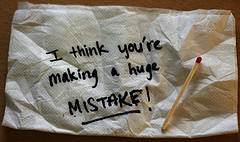 A web design is a blend of style, coding and purpose. An effective web design is the one which looks good, functions properly and entices the visitors to act upon the “call to action”. When you take-up web designing, you need to look at all the aspects and generate a website which is both, beautiful and useful. In order to create an outstanding website, the web designers often end up weighing certain aspects more than others; and thus the result is another web-design which showcases one of these seven common design mistakes.
A web design is a blend of style, coding and purpose. An effective web design is the one which looks good, functions properly and entices the visitors to act upon the “call to action”. When you take-up web designing, you need to look at all the aspects and generate a website which is both, beautiful and useful. In order to create an outstanding website, the web designers often end up weighing certain aspects more than others; and thus the result is another web-design which showcases one of these seven common design mistakes.
Excessive Use Of Flash
Web designers use flash to offer rich media solutions to the end user. The primary purpose of flash is to introduce animations and sound effects to static html pages. Using flash is considered (and it is) as a powerful medium to create an impact on viewers mind. Web designers use flash to exemplify the products (or the services) offered by websites. While flash is a good option for giving great look & feel to your website, it fails on the following fronts:
- Poor SEO: Flash websites are relatively poor at SEO. The algorithms implemented by the search engines work well on keywords (deep linking, using headline tags, etc), but improving the SEO for flash sites with graphics and images is tricky.
- Page Loading Time: The web pages designed in flash take more time to load as compared to the static and dynamic pages designed using CSS, HTML, JQuery, etc. Flash websites consume more resources (as compared to other designing techniques and technologies) to work efficiently.
Ignoring The URL Structure
The URL (Uniform Resource Locator) of the website is an identity of the website. A simple and keyword rich URL for various pages of the website work good for search engines. Composing complex and absurd URL structures are the most common mistakes while building a website. For example, when building a website in WordPress, you are provided an option for selecting the URL structure for the web-pages. Selecting a structure which allows you to add category or date-time to the post URL is a bad idea. Always select custom structure and provide the URL which holds meaning for the search engines as well as for the common users.
Browser Compatibility
Considering the browser compatibility is integral to web-designing. It is of utmost importance to test the website on various browsers; as all the browsers out there in market do not support all the features (as is the case with HTML 5 — which as of today is supported by Firefox 4 and Google Chrome). Some websites work well on Firefox, but fail to open up in Internet Explorer (which is used by the masses). If you are designing a website, you have to ensure that the website is compatible with all the major browsers in the market.
Neglecting The Power Of Social Media
Social media plays a crucial role in making your website rank higher than the others in your niche. It is highly adaptive and a major source for internet marketing. You cannot simply afford to neglect the power of social media. It serves as the platform for multiplying the number of visitors to your website. There are so many options available for making the most from social networking — social sharing toolbar, integrating Facebook like button, simple to use Tweet button, Linked in share buttons and so on. Social networking lets loose the bounds and reach of a website, thus giving the benefits of more traffic, better ranking and community building around the popular content of the website.

Broken / Dead Links
In the course of website maintenance and re-structuring, there are chances when you may change the URL of the web-pages. For example, when working on the SEO of the posts, you may change the title of the post for introducing the keywords (or archive the old content). Such acts result in broken or dead links and result in 404 error page. These broken links have an adverse impact on the end user and thus result in pulling down the page rank of the website.
Buried Pages
The web-pages which take more than two-three clicks to reach are commonly termed as the buried pages. This problem is basically encountered with weblogs, where everyday fresh content is introduced and the old content looses its identity in the purview of updating the blog. You can play smart and provide easy navigation to these buried pages through archives, popular / featured posts or by providing weekly links to the blog-content.
Ignoring User Queries
Web 2.0 has simplified the entire process of designing interactive web designs. It has established internet as a rich source of information and help. The way the websites function today have changed drastically. The websites now are the content management systems, where the users are free to query, comment or ask for help. These queries play an important role in building a community around the content offered by the websites, but for that, you have to be loyal to the users and answer the queries and respond the users of your website.
